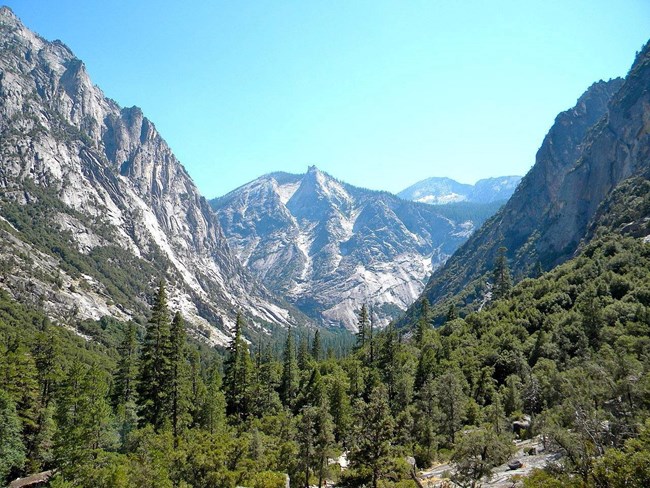Learn about NRCAs
The Natural Resource Condition Assessment (NRCA) Program provides framework, funding, and publishing support to parks to aid in the synthesis and documentation of natural resource conditions. Condition assessment reports are a tool to describe selected park resources, and record a snapshot of their current condition, identify trends, and identify potential or current threats and stressors. Understanding the condition and trend of natural resources is key for parks and NPS planners to appropriately prioritize and allocate stewardship resources.

NPS photo.
This dramatic landscape testifies to nature's size, beauty, and diversity—huge mountains, rugged foothills, deep canyons, vast caverns, and the world's largest trees. Change is a constant in natural landscapes, and it occurs at both large and small scales in these parks. Climate and fire are drivers of large-scale change, while the life cycle of a butterfly or a rockfall from a cliff are examples of change over a shorter time span or a smaller space. The significant elevation gradient provides an array of habitats for numerous plant and animal species which are protected from factors outside of the parks.
Traditional NRCA Report: 2013
In an effort to better understand the natural resources and processes within Sequoia and Kings Canyon National Parks, a Natural Resource Condition Assessment was conducted and published in 2013. Representatives from the National Park Service, the U.S. Forest Service, and the U.S. Geological Survey collaborated to determine park needs and available data. This team chose 24 resource topics to assess:
- Landscape context |
- Erosion and mass wasting |
|||||
- Air quality |
- Alpine glaciers |
|||||
- Soils |
- Animals of concervation concern |
|||||
- Water quality |
- Bats |
|||||
- Water quantity |
- Birds |
|||||
- Alpine environment |
- Cave invertibrates |
|||||
- Five-needle pine |
- Biodiversity |
|||||
- Foothills vegetation |
- Altered fire regime |
|||||
- Giant sequoias |
- Climate change |
|||||
- Intact forests |
- Non-native animals |
|||||
- Meadows |
- Non-native plants |
|||||
- Plants of conservation concern |
|
The overall conditions of these resource topics were mixed. Insufficient information, time and funding limited the team’s capacity to analyze, interpret, and compare the relative condition of all the parks’ focal resources and stressors. For example, comparative impacts of climate change, invasive plants, and pests and pathogens could not be determined due to insufficient data. However, the analyses showed that the parks are relatively unfragmented, provide protection to much of the state’s wildlife, and much of the high elevation habitats and sequoia forests. Stressors to the parks include decreasing air quality, altered fire regimes, invasive plant and animal species, and pathogens and diseases. The resource managers at Sequoia and Kings Canyon National Park will continue to adaptively manage for these stressors to ensure the protection of these valuable natural resources.
For other reports and natural resource datasets visit the NPS Data Store.
Source: NPS DataStore Collection 7765 (results presented are a subset). To search for additional information, visit the NPS DataStore.
Last updated: February 25, 2022
